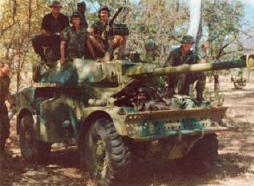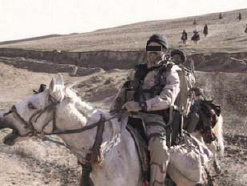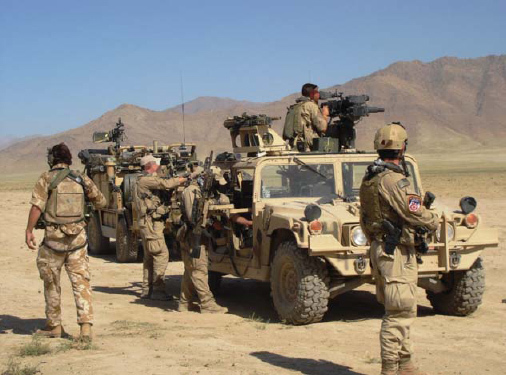Contact drill: The patrol, indeed every soldier, should be well practiced in what to do when the patrol comes under fire. The accepted general strategy is for the group under fire to take cover and return fire while the commander of the patrol arranges for some or all of the remainder to assault the enemy usually in a flanking attack. Of course when the patrol is small, such as a light reconnaissance patrol, it may be the SOP to cut and run in case of contact with the enemy.
When a large patrol comes under fire from a much stronger enemy force the commander may take the decision to disengage by a staggered withdrawal. Rather than forming an assault group the units not engaged may form another fire point further away from the enemy and the group first engaged would then fall back behind them. The withdrawal would continue by repeating this manoeuvre. Where air support is available the commander might choose to set up an instant defensive position and call in air support.
Separation drill: After a sudden contact, especially with a poor outcome, your patrol may be split and small groups or individuals find themselves separated. Before the patrol set off the commander should have explained what to do in this situation. During the briefing a patrol’s course should be split into what are called ‘tactical bounds’ and these may be marked as rest stops. Where the exact route is unknown these bounds may be set on the ground. Where a patrol is split it is a SOP in some armies for individuals to make their way back to the last stop.
In other circumstances it may be more useful for the separated members to make their own way back to base or seek an airlift. With the improvement in communications technology leading to many or all soldiers having some form of wireless communication separation has become less of a problem in recent years.
Tracking: I believe that all soldiers should be taught the basics of tracking owing to the immense value this skill has when operating in a rural environment. And there is a strong crossover between the skills of tracking and those required for spotting IEDs and mines. There is something of a mystique to tracking and, indeed, experts can look like magicians. I have followed many expert trackers and once followed an African who lead us across scrub and apparently featureless desert sitting on the front of an armoured car. He could track as quickly as it could drive!

Of course you would be a fool not to hitch a ride when you can. (Author’s Collection)

Around 25 years later and the idea of making the most of local transport is still catching on. Horses and traditional Afghan saddles courtesy of the Northern Alliance, rest of kit and equipment courtesy of Uncle Sam, c.2001. (DoD)
Most of us will never become so highly skilled but careful attention to the ground and surrounding vegetation can, with patience and practice, lead to anyone becoming reasonably proficient in the art of tracking. It is more a case of coming to notice details and getting a ‘feel’ for the signs of movement over an area. Often traces are noticed subliminally with the intuition leading the tracker forward. In the same vein, a patrol might want to consider avoiding leaving easy tracks when the circumstances warrant the effort.
Clearing patrol
Each morning it is SOP in many armies to put together a clearing patrol to investigate what has happened around the camp overnight. This patrol might consist of only 2–4 men and they should be looking for tracks or other traces of enemy reconnaissance, they would have the task of disarming ‘friendly’ booby traps and, after a night contact or firefight with the enemy, they would be doing a body-count and assessing enemy numbers from shell-case piles and losses from bloodstains etc.
Fighting patrol
This is a group strong enough to take on any enemy forces likely to be encountered and might be given the task of patrolling a certain area and denying it to the enemy. They would be seeking to meet and destroy the enemy by any means available to them. This would include a chance encounter, instant ambush or an attack on a prepared enemy position. The fighting patrol’s strength and attachment of specialist forces such as engineers or heavy mortars for an assault would be designed to meet the needs of the situation.
Reconnaissance patrol
Though replaced to some extent by aerial surveillance, the reconnaissance patrol still has the task of approaching the enemy’s position quietly and without detection, discovering strengths and weaknesses and reporting back to HQ. It is usually deployed as a preparation for a ground or air attack. The eyes of a reconnaissance patrol can be aided by the use of a small spotting drone but a reconnaissance patrol can stay in an observation position for weeks where an aircraft cannot.

Coalition SF frequently operate together in Afghanistan. Here US Navy SEALs are shown on operation with New Zealand SAS. The Kiwi is on the left and easily identifiable thanks to his distinctive camouflage pattern. (Photo courtesy of Leigh Neville)
Observation position
A specific type of reconnaissance patrol is the ‘OP’. This patrol fulfils a function sometimes difficult for aerial surveillance – it sits hidden in one place for an extended period to observe movement or whatever is of interest to ‘Intelligence’. This might be watching a bridge or river for signs of enemy movement. Normally a small group is used but on a long stint they may work in stags like sentries. On sighting the target the patrol may just report back or they may be required to call in artillery or an air strike. Staying on an OP is, I think, very often an undue risk and a waste of manpower and there are many occasions where it would be more useful for the patrol to set up a video camera with a transmission link back to base and come home. The camera can operate for an extended period, need never sleep and is much harder for the opposition to spot than a bunch of men.
Special operations patrol
There are various other tasks which may be set for a patrol-type unit. These include the demolition of a bridge or other structure, mounting mobile check-points, escorting supplies or prisoners and supporting the local police in the maintenance of order and public confidence in the rule of law.
Supporting the local police – or replacing them according to the situation – is very much a feature of the modern anti-insurgent function of the military. Where insurgents have compromised the local government or police and temporarily succeeded in their aim of imposing their will on the local populace, it is often necessary to mount foot patrols around the streets not only to catch or deter the terrorist but to reassure the local people that someone is there to protect them and that the rule of law has returned.
An example patrol
As an example often makes these things clearer I’ll tell you about a patrol I took down the banks of the Zambezi river some years ago.
My mission was to ambush and destroy any insurgents crossing the Zambezi river from Zambia into what was then Rhodesia. Zambia was being used as safe ground for training and supply in a similar way to how Pakistan is used today. I had to perform this task for a couple of weeks in different places at my discretion and had just four men, besides myself, to carry it out. Given each group of insurgents might number in the dozens, surprise was of the essence.
The Zambezi is a very wide river and just to complicate things it is thick with crocodile and hippo. I once saw an 18ft crocodile on a sandbank in the Zambezi. And while hippos have a good press, they are actually one of the most fierce and dangerous animals in creation – even the big crocodiles are scared of them. And so are the locals as a hippo will bite a canoe cleanly into two pieces.